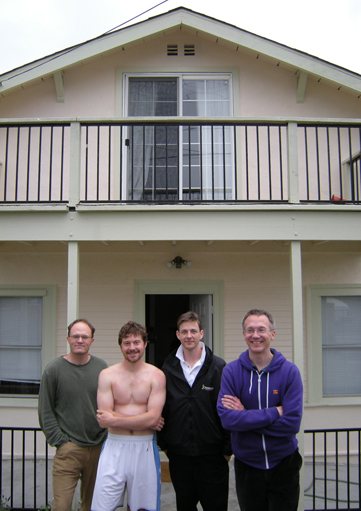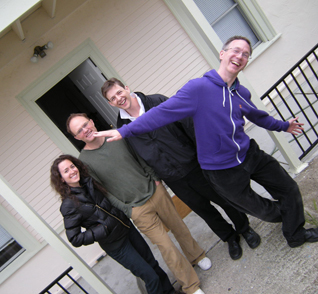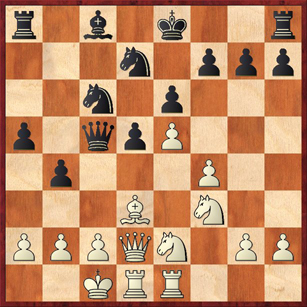Although the Reno tournament is over, you’ll probably see at least two or three more blog posts on it, as I work through my games from the tournament. But for now, let’s skip the heavy-duty analysis and talk about a few odds and ends from the trip.
The GM House
I picked Jesse and David up at their house on Thursday afternoon, the famous GM house. Naturally I had to bring my camera and take pictures of this historic landmark before it gets a placard and all the tourists start crowding around to see it. Here are Jesse, David Petty (an expert who is currently rooming with them), David Pruess and me. Photo taken by Irina Krush.
Of course, we also needed to have a picture with Irina in it, so here is another photo taken by David Petty. I don’t get why Irina, Jesse, and David are leaning over at such a crazy angle. Don’t they know that we have earthquakes in California? 😎
GM Lev Psakhis Coming to Berkeley
Hot off the presses! On Friday I was listening to David Pruess talking with Vladimir Naroditsky, the father of Danya and Alan, and I couldn’t believe my ears when I heard Dr. Naroditsky say, “Did you know that you have a guest coming? Lev Psakhis is going to come and stay at your house in May.”
Faithful readers of this blog may remember my post from January about Psakhis. I had no idea when I wrote “Whatever Happened to … Lev Psakhis?” that he would actually be coming to the Bay Area in a few months! Actually, Pruess seemed just as surprised as me. He hadn’t heard anything about it, so Dr. Naroditsky said, “Talk with Jesse.” Jesse happened along a couple of minutes later, and David asked, “Is it true that Lev Psakhis is coming to visit us?” Jesse said, “Apparently.”
It seems that John Donaldson met Psakhis at the Olympiad last November, when Psakhis was coaching the Indian team, and invited him to come to San Francisco. Dr. Naroditsky was very keen on getting Psakhis here to work with Danya, and so he has been in contact with the former Soviet champion since then. Psakhis will be staying with the boys and Irina at the GM House for a week, and then he will stay with the Naroditskys for a little while. Jesse said that they will actually be paying Psakhis for a week of coaching, so it’s not like he is going to be just a normal house guest crashing on the sofa. Still, it will probably be money well spent.
The Gift that Keeps on Giving
A position from David’s last-round game against Curt Collyer. Does it look a little bit familiar?
Again, faithful readers of this blog will recognize this from the spectacular game Pruess-Kraai from last December. In this position Jesse got careless and played 14. … O-O, and David destroyed him with the bishop sac 15. Bxh7+! It’s a really beautiful game, and there is more to it than just the initial bishop sac, so if you haven’t seen the game you should really check it out.
Postgame analysis showed that Black is doing fine if he plays 14. … b3! instead. This move takes advantage of the fact that White has left his king on the c-file. (Normally White prevents this by playing 14. Kb1 first, but Pruess’s idea was to try to avoid wasting a tempo on this move.) The idea of 14. … b3! also is that after 15. ab a4! White will be unable to prevent the march of the a-pawn and/or the opening of the a-file.
David said that he felt a little bit weird about playing this line again, knowing that Black can equalize. To someone who doesn’t know the position, he said, 14. … b3 is a very far from obvious move, and he really likes White’s chances in the other lines. (Such as 14. … O-O, when White wins by force!) So he took the gamble that Collyer wouldn’t be able to find it.
Sure enough, Collyer played 14. … Nb6 instead. And now Pruess once again has a nice resource: 15. N2d4! Nxd4 16. Nxd4 and of course 16. … Qxd4?? would lose the queen to 17. Bb5+ (a common trick in the French). So now White basically has his ideal position, all of his pieces developed and the d-pawn blockaded. Collyer played 16. … Ba6 17. Bxa6 Rxa6 18. f5! and White’s attack was decisive. Black’s kingside is too weakly defended, the rook on a6 is out of position, and Black’s pieces just don’t make any sense, while White’s are perfectly coordinated. For the rest of the game, go see David’s blog entry at www.chess.com. This sure makes playing against the French look easy!
A Leetle Bit of Chess Politics
Normally I don’t write about chess politics, and I think I have never even voted for the USCF’s Executive Board. But one of the nine candidates, Ruth Haring, was playing in the tournament this weekend, and she talked with me a bit. She sounds very level-headed; she is running for the board for the right reasons (to benefit U.S. chess) rather than for the wrong reasons (self-aggrandizement). In the current dysfunctional environment, where everyone is suing everyone else, it takes a lot of courage to run for the board, but of course that is why it is even more important to get people of good character to run. Notice, also, that in her candidate statement in Chess Life, Haring does not say anything negative about anyone else; she only talks about the positive things she wants to do for the USCF and U.S. chess.
Ruth has been out of chess for many years, working at a number of big Silicon Valley companies like IBM and eBay, and so she would be coming to the position with valuable business experience and with a lot of fresh enthusiasm. This is exactly the sort of person that we need helping out our chess federation. So I’m going to endorse Ruth Haring. Vote for anyone else you like for the other three positions, but please make sure to vote for her! Check out her website, www.ruthharing.com, if you want to read more.
The Talented-Younger-Sibling Phenomenon
By the way, it was a good weekend for the Naroditskys. Daniel went 4-2 and was part of the six-way tie for seventh place. Perhaps that is only a so-so result for him, I don’t know, but to me it sounds pretty good. Also, the “other” Naroditsky, his older brother Alan, went 3.5-2.5 and tied with me and two other people for the expert prize. I think you have to admire somebody who has been so much overshadowed by the international success and attention heaped on his younger brother, but who has stuck with chess and is making good progress of his own.
I had a somewhat similar experience myself as a kid. My sister was a great swimmer, winning lots of state championships when she was 10 and 12 years old. Meanwhile I was completely average in the pool, so when I was 12 I decided to quit competitive swimming. It was probably the first time in my life that I independently made a decision like that, instead of just doing what my parents told me to do. I think it was a good choice. That was just about the time when I started really getting interested in tournament chess, and I’ve never regretted it! But still, I can definitely relate to the talented-younger-sibling phenomenon.
In fact, there was another pair of brothers at the Reno tournament with exactly the same story. Luke Harmon-Vellotti, mentioned in this blog post, was the highest-rated 9-year-old in the country last fall. (He may be 10 now, I’m not sure.) His older brother, Carl, is “just” a class-B player. But they both entered the Open section, even though Carl was the lowest-rated player in the section, and this time the older brother got even! They tied with 2.5-3.5 scores. Okay, admittedly Carl’s score included a full-point bye in round 1, but nevertheless he proved he belonged, with a win and a draw against experts.
Full Results
Finally, if anyone out there wants to look at the full results of the Reno tournament, they have been posted on-line right here. That’s all for today!





